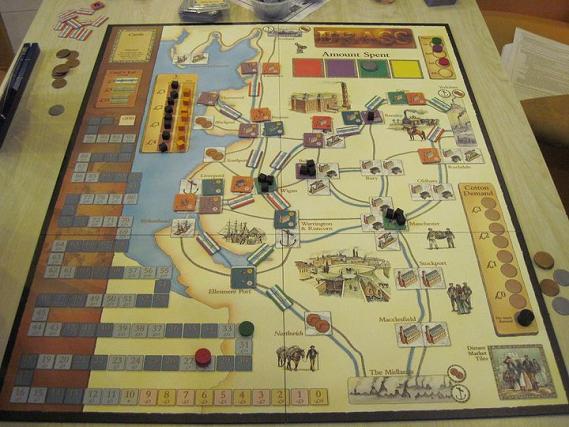2 Jun

The game is set in a specific county of England. That seems awfully provincial to me.
I’ve been feeling a bit under the weather of late and Brass is too big of a game to do justice to with just one play, so I’m just writing a summary of some of my thoughts on it. It’s an economic game by Martin Wallace and set during the Industrial Revolution, so comparisons with Age of Steam seem natural.
- Components are much better compared to Age of Steam which is a big win for me. I prefer this map style as well with cities linked by predefined routes instead of the total openness of the former game. Looking at the hex map simply puts me at a loss at where to start and what to do, whereas I can look at the map in Brass and think about opportunities and strategic possibilities.
- Rules were very unintuitive at first, what with unflipped tiles being worth nothing. It’s even more painful when you realize that all of the level 1 tiles leave the game at the end of the canal phase. It took me the entirety of the first phase to fully understand what I was supposed to do. I didn’t even appreciate the importance of development actions until after the game.
- I didn’t fully realize the implications of the coal and iron available on the market either. I allowed some of my actions to be limited because I didn’t see any of these resources available but I should have been more willing to buy them off the market when necessary. The demand and supply curve this mechanic simulates is a very nice touch. If you buy something off the market, the next player in turn will have an incentive to build something to fill the demand.
- Loans seem much less painful in this game, perhaps too much so. I only took a loan once but perhaps I should have done it more as I didn’t have money to build two railways tracks in one action at the beginning of the rail phase. Since income level doesn’t affect victory standings at all, there seems to be very few downsides to financing yourself this way.
- Shipyards score a lot of points! But the key here is that there are very few spots to build them in plus two of the spots are very inaccessible. This feels a bit odd to me as getting the location cards for these two areas then become very critical. Surely the game shouldn’t be about racing to get these key cards?
- I like using cards to restrict player actions. It helps to limit the possibility space that you need to consider when deciding what to do, while allowing unfettered freedom if you’re willing to give up two cards to do any action. The added element of hidden information also adds a welcome bit of tension and allows players to scheme a bit more. Do I have the time to delay building in a key location or does my opponent already have the right cards to snag it from me?
- Overall, this is another very crunchy economic game with lots to calculate but I like this one a lot more than similar stuff like Age of Steam and Power Grid. It seems to me that there are actually valid alternate paths to victory in Brass, because points can come from a variety of sources, whereas the two other games seem to be have more singular goals. Plus the card-based restriction discourages you from trying to calculate everything down to too much detail. For this reason, I’ll be much happier to replay this one than the other two games.

Cards that name a specific city allow you to build anything in that city. Cards that name an industry allow you to build the corresponding building in any city, provided that you already have a network leading to that city.
Written on June 2 2010 and is filed under Boardgames.
You can follow any responses to this entry through the RSS 2.0 feed.
You can leave a response, or trackback from your own site.
Leave a Reply